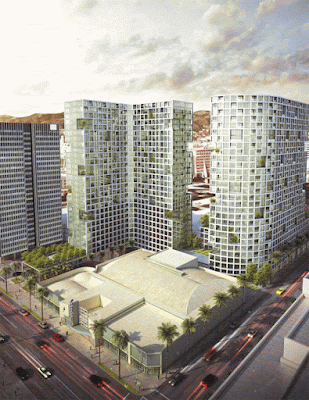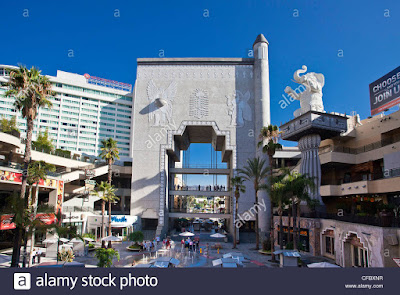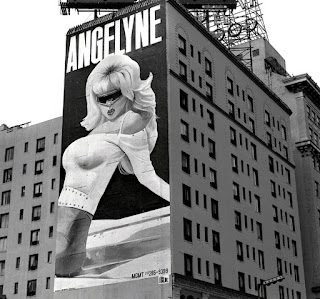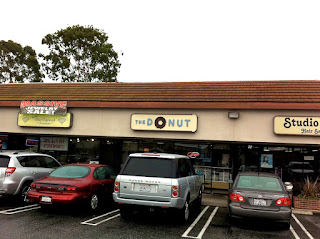 |
| Hollywood Palladium Residences rendering Hollywood, California urbanize.la |
Today we are going to take a break from the Presidential elections and look at a ballot initiative that will appear on the Los Angeles County ballot that will affect the future of Los Angeles. Josh Stephens recently posted an article on the California Planning & Development Report, on the Neighborhood Integrity Initiative sponsored by the Coalition to Preserve L.A (http://www.2preservela.org) that would upend the city's approach to project approval and long range planning and development.
The CPLA is an offshoot of the AIDS Healthcare Foundation, headquartered across the street from the landmark Palladium. The impetus for this initiative is the proposed Hollywood Palladium Residences. Mr. Stephens writes, "...the proposed Hollywood Palladium Residences may be one of two things: a proud testament to a progressive city's embrace of smart growth, or a 28-story symbol of the hubris of Los Angeles' planning and development community." Who would support the city's current system of long term planning and project approvals? It seems that no one would vote in favor of the current system but that is not the question before voters.
The initiative would essentially place a two-year moratorium on all development that does not adhere to adopted plans. It calls for Los Angeles to update its 37 Community Plans and prevents City Council "...from granting plan amendment which supporters of the initiative derisively refer to as 'spot zoning,' to nonconforming projects."
 |
| The Hollywood Palladium amp.cbslocal.com |
Enact a two-year moratorium on building or demolition permits for projects that do not adhere to existing city planning regulations and/or for which the city granted a General Plan amendment, or zone or height change;
Permanently halt individual parcel-by-parcel or 'spot zone' amendments and/or building exemptions by outlawing amendments intend to approve project "where the approval of such projects would otherwise be inconsistent with the General Plan;
Create a plan for updating the city's Community Plans according to strict principles prescribed by the initiative, including requirements that force developments to conform to size and character of existing developments within a quarter-mile radius, including those surrounding transit hubs;
Requires the city, not developers, to be responsible for preparation of Environmental Impact Reports; and
Limit a developer's ability to reduce parking requirements for residential units and limit commercial establishments' use of off-site parking.
 |
| Hollywood Palladium main room laweekly.com |
The Improvised City
The City of Los Angeles is not exactly a well ordered, nicely planned out city. Josh Stephens writes, "Generations of planners, developers, and stakeholders have decried Los Angeles' planning scheme as inefficient, Byzantine, and unenlightened." The city's General Plan has not been fully updated since 1946, and the current pace for updating all the Community Plans-part of the General Plan not mandated by the state, imposed by the city on itself-is moving at a very old turtle's pace. Even the Department of City Planning describes it "cumbersome." Not very encouraging, is it.
 |
| Vine Street c.1971 Hollywood, California vintag.es |
Jill Stewart, journalist and CPLA Campaign Director, told Josh Stephens,
They amend the city General Plan sometimes on a daily basis...It's an outrageous practice.
One of the biggest concerns of CPLA supporters are the "mega-projects" that are often composed with luxury condominiums or high-end rentals that clash with their concept of Los Angeles's traditional urban character. The most controversial projects are located in Hollywood, "...where city planners have been promoting new development to replace the area's formerly seedy image.
 |
| David Bowie's star on Hollywood Boulevard yelp.com |
Coalition to Preserve L.A claims "...that the initiative will preserve existing housing stock." Ms. Stewart claims that about "...20,000 units have been lost in the past decade to new, presumably more expensive, developments."
Specifically, Ms. Stewart said,
I don't think they're purposely going after the working class, but that is the outcome-shoving out people who cannot pay the incredible prices, people of color, and actually cause a net loss in Hollywood.
Coalition to Preserve L.A hopes that the initiative will bring stability to the development process and even combat the city's ongoing affordable housing. The initiative's supporters say that, "the current system invites developers to pressure the city to approve larger and more luxurious-and therefore more profitable-project." To be precise, "If developers know that a parcel is zoned only for a certain typer of property, developers will avoid the lengthy negotiation process in favor of simply adhering to statute. (The initiative would affect ministerial approvals such as variances.)"
 |
| Low income neighborhood with Capital Records in the background Hollywood, California streetgangs.com |
Expressing a note of cynicism, Jill Stewart said,
After the moratorium ends...everybody will know what going to happen, and there will be no horrible surprises.
Critics of the initiative say that it "...promotes a regressive vision of Los Angeles as a low-rise, low-density bedroom community, when market and cultural forces are promoting density." By doing so, the initiative dismisses contemporary planning philosophies like smart growth, infrastructure development like transportation, and cultural shifts that have made urban so attractive once more.a Although some "mega-projects" have been derided, to planners, they symbolize the emergence of more energetic, more urban Los Angles. Ms. Stewart dismissed this notion,
All of the urban planners are in on this same idea...It's a religious chant you hear.
 |
| Hollywood City Inn pool Hollywood, California hotelsharbor.com |
It's the impulse to fundamentalism that people feel when they sense the world is collapsing around them...This is no different than any other fundamentalist movement, whether it's Christian fundamentalism or Islamic fundamentalism. It sounds melodramatic, but when the world ceases to make sense, we retreat to text. Unfortunately, does a really bad job of putting the world in order, so you end up with this downward spiral.
Allusions to religious fundamentalism, seriously? Melodramatic? You think?
'Great Wealth' or Slim Margins?
Generally, plan amendments require Planning Commission and City Council approval. Council members usually vote along with the council members in whose district a proposed projected is located, therefore, giving elected official almost absolute power over development decisions. Planners see this as an imperfect process but more quick than spending decades haggling over comprehensive plans. CPLA says that "...these actions amount to 'back-room deals' that serve only to enrich powerful developers."
 |
| Sunset Boulevard through Hollywood gettyimages.com |
...the power to create great wealth.
The corruption trials resulted in safeguard being implemented to ensure transparency.
Urban planner dispute the way CPLA characterizes the opacity of the process. Proposed development projects that ask for plan amendments are required to run the gantlet of public meetings in which individuals and organizations can voice their concerns and make suggestions. Josh Stephens writes, "The creation of the Neighborhood Council system in 1999, when the city updated its charter, added a forum that was absent during the corruption scandals of the 1960s." Retired deputy director of planning for the City of Los Angeles Alan Bell told Mr. Stephens,
I don't buy the argument that you have favoritism shown to particular developers...Every one has got through a rigorous review process.
This sentiment was dismissed by Jill Stewart.
 |
| Hollywood and Highland complex alamy.com |
By the time the public hearing has come around, a tremendous amount of decision-making has already happened.
She went on to say "...that many otherwise idealistic council members get increasingly comfortable with this system as their terms progress and they get re-elected." She added "...that many residents have vehemently opposed 'mega-projects' only to be disregarded by planners and elected officials." In the end, you have projects that service the developers's financial interests but alienate the people from their communities. Ms. Stewart said,
The biggest thing I hear is the destruction of the neighborhood character...Most people don't believe that...LA is a good place for a lot of high-rise skyscrapers.
 |
| Traffic on Hollywood Boulevard b/w gettyimages.com |
Opponents of the measure say CPLA's supporters have the economics backwards, "...because high land prices reflect a market that is already constrained by antiquates zoning laws. The moratorium and constrained Community Plans could exacerbate an already dire housing shortage and affordability crisis and stall nascent efforts to solve it."
Stephanie Pineeti, the director of the California Center for Sustainable Communities at UCLA, said,
Densification occurs because of land prices and land consolidation for really big projects.
Land prices produces a costly negotiation process in which developers and the city try to establish what should be permitted on a particular parcel while developers attempt to maximize their investments. This process often includes expensive consultants and community outreach, as well as environmental impact reports for some projects and looming threat of lawsuits under the California Environmental Quality Act. In the interest of clarity, some of CPLA's supporters have sued under CEQA to combat projects in Hollywood. Mr. Bell told Mr. Stephens,
The market is responding appropriately based on low-density zoning that we've had in place for such a long time.
 |
| Angelyne Hollywood, California flickr.com |
Los Angeles city official have been adamant about the transparency of the process and in line with "...well-established goals-even if those goals have not yet been codified." Josh Stephens writes, "In particular, the General Plan Framework, adopted in 1996 and re-adopted in 2001, outlines many of the principles that guide today's plan amendments." Alan Bell disagrees with CPLA's characterization of a corrupted process,
Nothing could be further from the truth...All of these re-zonings and amendments to the community plans have consistent with (the General Plan Framework).
The City Council has frequently approved plan amendments for development project that fit within its progressive vision for Los Angeles, instead of waiting decades for the long-range planning process to yield updated Community Plans and zoning. This is precisely what CPLA rejects, the attempt to circumvent antique regulations that persist only the process moves at a turtle's pace.
 |
| Hollywood Christmas Photograph by WPA Film Library gettyimages.com |
...the current disruption and traffic in areas like Hollywood, Downtown, and Mid-Wilshire is temporary and should not dictate long-term policy...The impacts of this new development trend are obvious. These gigantic buildings are sprouting up and the public transportation that's benign built is very disruptive...It's really for a change that's going to happen for the public good in Year Two or Three or Four. It's always difficult for people to keep that in mind.
Alan Bell picks up the thread saying,
...the guidelines themselves have a long lineage, taking inspiration from the Centers Concepts that former Planning Director Cal Hamilton drafted i 1974...I think there's been a consistent message from the Planning Department going back over 50 years that the way L.A. can grown and develop while retaining its special character (is to) channel its growth near transit.
 |
| Planning map of Los Angeles zimas.lacity.org |
In 2015, Mayor Eric J. Garcetti "...announced his intention to promote development of 100,000 units between 2013 and 2021." Almost 40 percent of those units have received approval, often through plan amendments, with more under construction. Said plan amendments have allowed planners and elected officials to break through these limits in some cases. City Planning Commission member architect Renee Dake-Wilson said,
Almost every project that comes to the Planning Commission is about housing...Policies are coming in our agenda are all about housing, not only affordable housing, all levels of housing."
 |
| How tall is tall? savehollywood.org |
Just the same, in 2015 the city adopted a new mobility element-Mobility Plan 2035-which attempts to promote the use of alternative transportation as a way to alleviate some of issues arising from density. In the meantime, the city is currently undertaking a comprehensive review of its zoning-re:code LA.
More important, Mayor Garcetti recently appointed Vince Bertoni to lead the Department of City Planning. As the former planning director for Pasadena and former Los Angeles deputy director, Mr. Bertoni is a champion of long-range planning and is expected to light a fire under the Los Angeles process. Ms. Dake-Wilson, who opposes the initiative, said
I really hope that we can get beyond setting policy by ballot measure and start doing it by setting correct policy and reviewing cases.
 |
| Department of City Planning logo cityplanning.lacity.org |
This forces them to have a public process that they've been avoiding for 20-20 years, said Ms. Stewart.
Yet, regardless of what the public wants, engagement over a new Community Plan would not exactly be a free-for-all if the initiative does pass. It included limitations on plans that might be adopted, including a requirement that any new development must fit the character defining feature of the existing urban fabric within an a quarter-mile radius. This could restrict transit-oriented development and effectively end the Centers Concept.
 |
| Los Angeles strip mall thepauperedchef.co |
The sorts of development that drive people craziest-the out of scale condos, the ugly strip malls, the fast food joints-those will be the only game in town.
Mr. Smith even predicts that the city's vibrant nightlife could be hamstrung. This dire warning is based on his understanding of the initiative which would require new bars and restaurants to meet their on-site parking requirements.
Housing Crisis Meets Planning Crisis
 |
| Dingbat apartments Los Angeles, California archaizer.com |
Bars and restaurants aside, the initiative's greatest impact would be felt in housing. Mr. Stephens reports, "CPLA claims that housing affordability is one of the primary motivation behind the initiative, especially for low-income residents and people of color." The supporters of the initiative believe that "stability in the public process will open up opportunities for small developers to produce subsidized and working-class market-rate housing and thereby meet Garcetti's goals." Ms. Stewart continues,
The mid-sized and smaller developers who have been shut out of this gamed system will be much more active.
Opponents of the initiative say that this is, at best, a roll of the dice. Specifically, "If small developers do not seize the opportunity that the coalition describes and, meanwhile, large developers are shut out, the city's production of new housing may fall to nil-in a city that has been described as the least affordable in the nation as function of average wages and rental rates.
Mr. Smith continues,
It is already true that small developers are build as much as they can in the medium-density residential neighborhoods all over the city.
He believes that small developers do not actually have excess capacity to make up for the unit that larger projects would provide. If this is the case, then the Los Angeles is facing at least two years of minimal housing construction. Mr. Smith sums up the situation,
Rather than fighting for housing affordability-which would mean supply-they have put all of their chips in with the NIMBYs and have basically decided that land use is a zero-sum game.
 |
| Artist rendering of the Palladium Project Hollywood, California lain dependent.com |
Jill Stewart also said that population growth was slow enough to necessitate a slower rate of development, couple with housing preservation.
L.A. is not a fast-growing city at 1.2 percent (per year)..There is not a crush of people arriving here.
City Planning's official statistics "anticipate a population of 4.3 million in Los Angeles by 2035, for an absolute increase of 300,000." A 2014 California Housing Partnership reported "estimated that Los Angeles County already has a shortage of 490,00 affordable units (market rate and subsidized)." Mayor Garcetti's spokesperson Connie Llanos said,
The mayor is concerned that this initiative would dramatically cut housing production in Los Angeles, driving up rents at all income levels at a time when too many Angelenos are already struggling to make ends meets.
 |
| AIDS Healthcare Foundation logo charitybuzz.com |
While the battle between civic watchdogs and developers has been raging for decades, this latest round has one usual instigator, the AIDS Healthcare Foundation. Blogger knows what you might be thinking, an AIDS Healthcare organization getting involved in planning issues? Technically, the AHF does not list CPLA or the initiative on website but the the two are one and the same and you can find a .pdf of the measure on their website, http://www.aidshealth.org. Despite their mission to bring "Cutting-edge medicine and advocacy, regardless of ability to pay," (Ibid) and this initiative has absolutely nothing to do with AIDS treatment or prevention, the AHF's leaders believe that over-development and increased density are matters of public health.
AHF was initially focused on Hollywood. The initiative spreads their concerns throughout the city. Board Chair Cynthia Davis told Josh Stephens,
We felt it was appropriate given that...this is occurring out our front door...When I drive over to our corporate offices, I can't even find a parking space. I have to drive 20 minutes to find a parking space.
Ms. Davis said the initiative has nearly the unanimous support of the board. She continues,
We're concerned about the health of communities whether or nor somebody is living with HIV or AIDS...You're talking about too many people living and residing in a particular area where it's going to affect the environment, parking, homeless people on the street...thousands of people moving into an area that's already congested.
 |
| CPLA campaign billboard businesswire.com |
 |
| Magic Johnson billboard businesswire.com |
Setting aside the AHF's expertise, or lack thereof, in land use, for the moment the question on the table is: "Can the Neighborhood Integrity Initiative-or any other movement-bring the reform that so many in Los Angeles have clamored for?"
In Blogger's own assessment of the matter, the opponents of the initiative make a slightly better argument than its supporters because the facts bear this out. This is not to say that yours truly is a high-density, developer friendly blogger, it is just that the opponent favor a more incremental change, something more doable, than sweeping reform. Be that as it may, the supporters of the initiative have the backing of homeowners, homeowner association, and other groups typically concerned bout traffic and overbuilding. Even those opposed to the initiative admit that it sends an anti-corruption message that sounds attractive to voters. Mott Smith had this to say,
To the unsophisticated ear, this will be an extremely seductive proposition...What it says, the city has to stop deviating from its own rules on a case-by-case basis for developers. Who would disagree with that? Only someone who understands the rules have never worked and could work.
Meanwhile, the initiative moves toward the November ballot. Even though it will only appear on the Los Angeles County ballot, it has implications for other cities facing a similar housing crisis. Affordable housing is a major issue that all cities must deal with. At its basic level, it can distilled to a case of supply and demand. In Los Angeles, the demand for affordable housing has outstripped the supply and potential renters are being frozen out of the market. The real question is what do Angelenos want to do about it?
No comments:
Post a Comment